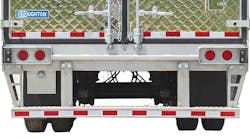Federal Motor Vehicle Safety Standards for trailer rear impact guards (RIGs) have led to uncertainty for roadside inspectors, costly safety violation points and delays for fleets, and anxiety for repair shops. So, among other initiatives, the Commercial Vehicle Safety Alliance will ask the US Department of Transportation to remove the requirement for OEM certification labels on RIGs, also known as underride guards and ICC bumpers.
The petition letters to the National Highway Traffic Safety Administration and the Federal Motor Carrier Safety Administration were expected to be approved by the CVSA board at its meeting in late February, according to Kerri Wirachowsky, director of the roadside inspection program. CVSA is the umbrella association for North American safety officials.
She addressed the issue in a Feb. 13 webinar for CVSA members to review the RIG inspection standards.
“Most of the enforcement staff on this webinar should have been involved with a new initiative back in August, where we asked every jurisdiction to go out and inspect rear impact guards and supply us with data for one day of inspections,” Wirachowsky said. “So the recommendations from that initiative came back to the vehicle committee and the Board of Directors, and it was discussed in Kansas City [at the CVSA Annual Conference].”
In her presentation, along with explaining the petition letters, Wirachowsky noted the change to CVSA Operation Policy 15, which informs roadside inspectors of approved interpretations of DOT regs. Specifically, CVSA has added guidance “to NOT cite a violation for a missing certification label” in the US, an interpretation that finds the label requirement pertains to the manufacturer, not the end user.
Another change to the CVSA guidance concerns Operational Policy 5, indicating that a CVSA safety inspection decal will not be applied to a vehicle that has a violation of a required rear impact guard.
“It’s not a critical inspection item, because there is no out-of-service criteria for it yet at this time,” said Wirachowsky. “But we don’t want CVSA decals going onto a trailer that has a violation of a rear impact guard.”
The presentation also touched on the range of exemptions from the RIG requirements for trailers over 10,000 lbs.: pole trailers, pulpwood trailers, low chassis vehicles, wheels-back vehicles, special purpose vehicles and trailers towed in driveaway/towaway operations.
In a Q&A session following the presentation, the issue was raised regarding the inspection of a repaired bumper; specifically, of assessing the quality of a weld.
“That isn’t something that you’re going to be able to deal with roadside. That’s some of the discussions that we’ve been having with FMCSA and other folks,” she said. “We’re not going to be able to get into the testing and everything else in regard to it.”
The upsurge in RIG-related enforcement incidents stems from the Stop Underrides Act of 2017, to reduce the number of preventable deaths and injuries caused by underride crashes. CVSA received a letter from bill sponsors Sens. Kristen Gillibrand and Marco Rubio in February last year asking the alliance to consider updating its current North American Standard Out-of-Service Criteria to add rear underride guards.
Subsequently, in August, state commercial motor vehicle enforcement departments initiated a RIG-focused inspection period and survey to collect usage data. And that’s when fleets and trailer repair shops got concerned. Strict enforcement of the label requirement and the improper application of RIG rules on exempt vehicles were the source of complaints at the TMC fall meeting in September; later in the fall, calls started coming into the National Trailer Dealers Association.
“It’s become kind of a contentious issue, apparently,” NTDA President Gwen Brown told Trailer/Body BUILDERS.
As an example, Brown suggested an incident where a trailer built by one OEM was involved in a rear-end accident and towed to a nearby trailer dealership affiliated with a different manufacturer. The repair shop likely would not stock the OEM replacement RIG. And, depending on the interpretation of the label standards, the shop could be exposed to liability by installing a different guard. Sometimes there is also a matter of competition and lack of cooperation among repair facilities, she noted.
“There seems to be a lack of education,” Brown said. “We all need to work together to make sure that we’ve got the part to get these drivers back up and down the road. And time is obviously very important to them. But we also need to make sure everyone understands what the requirements are for the rear underride guards and that certification label.”
The specific standards for trailer RIGS are FMVSS 223 and FMVSS 224.
Look for additional coverage in the March print issue, or on the TBB website.










